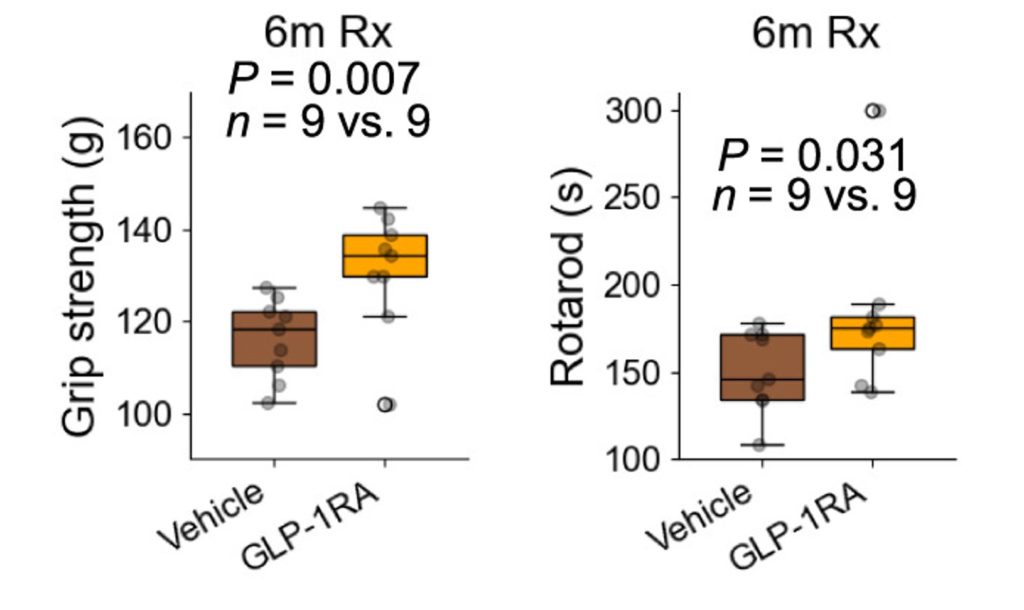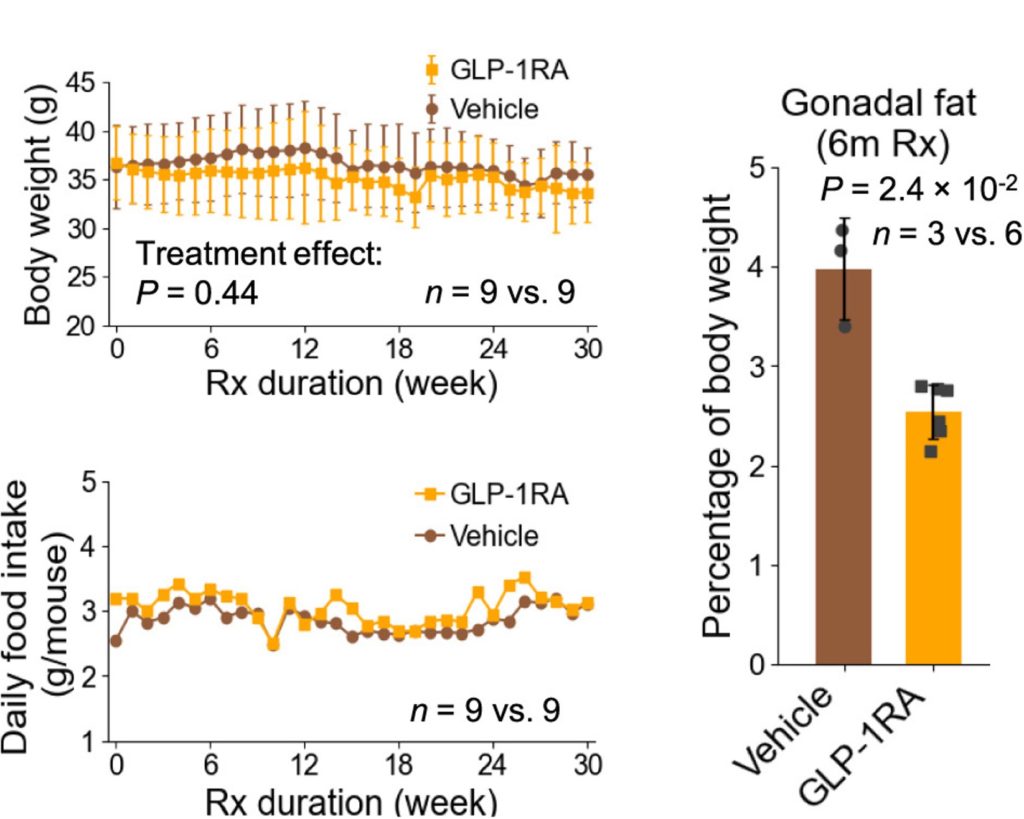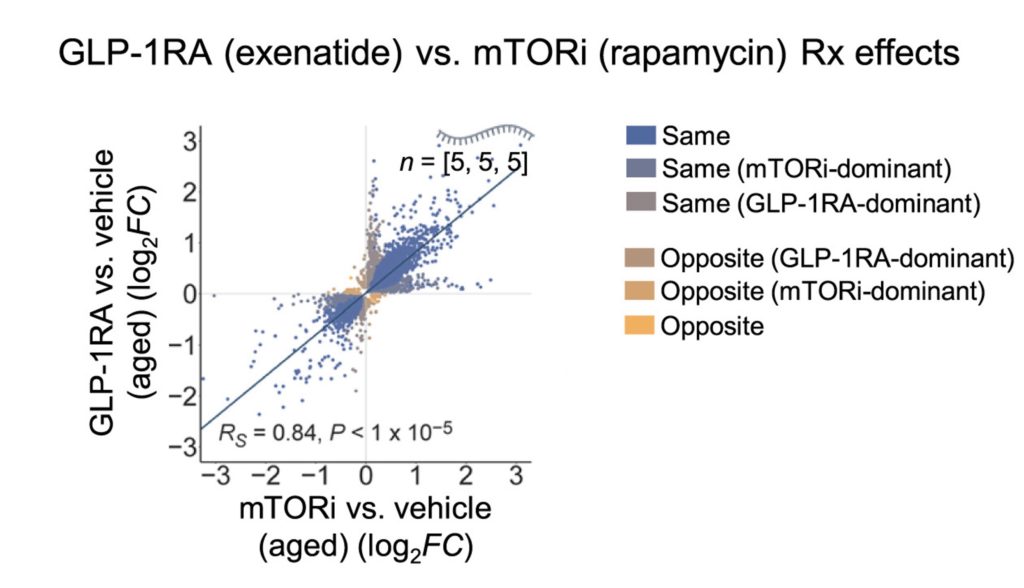GLP-1 Drug Counteracts Aging Independent of Weight Loss in New Study
The type 2 diabetes drug exenatide counteracts physical but not cognitive decline in mice, while going head-to-head with the powerful longevity drug rapamycin.
Highlights
- Exenatide counteracts physical but not mental decline, and promotes anxiety.
- Exenatide does not cause body weight loss or suppress appetite, but reduces visceral fat.
- Compared to rapamycin, exenatide similarly alters genes in multiple tissues.
According to some researchers, the ideal anti-aging method will have:
- A good safety profile and wide therapeutic dose range.
- Broad applicability to multiple age-related chronic diseases.
- Potential synergistic effects with other anti-aging interventions.
Few interventions satisfy these criteria, but forward-looking scientists are looking towards GLP-1 receptor agonists (GLP-1RAs). GLP-1RAs, such as Ozempic, are currently prescribed to treat type 2 diabetes and obesity. Now, as part of a new study published in Cell Metabolism, researchers from the Chinese University of Hong Kong have begun investigating whether GLP-1RAs counteract aging.
Exenatide Counteracts Physical but not Mental Decline
Aging is accompanied by both physical and mental decline. To this end, the researchers tested the physical and cognitive performance of middle-aged mice, choosing this age to capture the early stages of age-related decline. As expected, the grip strength and coordination of the mice declined over six months. However, perhaps unexpectedly, there was no significant decline in cognitive performance.
To determine the effect of GLP-1RA, the researchers injected exenatide into the mice’s abdomen (peritoneum). Six months of this prescription led to greater grip strength and coordination, but not cognition. These findings suggest that exenatide counteracts physical but not mental decline. When it comes to emotions, it was shown that exenatide increases anxiety-like behavior, a potential unwanted side effect.

In 2024, a large study of over 160,000 individuals showed that GLP-1RAs are associated with a 195% higher risk of major depression, 108% increased risk for anxiety, and 106% elevated risk for suicidal behavior. This supports the idea that GLP-1RAs promote anxiety-like behavior. Notably, many human studies of GLP-1RAs exclude people with a history of major depression, which could be why this side effect has gone under the radar.
Exenatide Does Not Cause Weight Loss
In humans, exenatide is known to lower blood sugar, leading to weight loss, which can counteract age-related diseases and early mortality. To work around these effects, the researchers gave the mice a low dose of exenatide. As hoped for, exenatide had no significant effect on blood sugar or body weight, revealing (along with the other results) that exenatide reaps anti-aging effects independent of lowering blood sugar and body weight.
Exenatide also did not appear to induce appetite suppression, a major effect of GLP-1RAs, as the food intake of the mice remained steady. It did, however, lower gonadal fat, a type of visceral fat located in the region of the gonads. Excess fat is associated with an increased risk for type 2 diabetes and heart disease. Excess fat can also increase chronic inflammation, an underlying biological driver of aging.

Exenatide Goes Head-to-Head with Rapamycin
Chronic inflammation sits atop the ever-growing list of underlying biological drivers of aging, called the hallmarks of aging. Other hallmarks of aging include dysfunctional proteins and cellular senescence, where cells stop functioning properly and begin spewing pro-inflammatory molecules. Autophagy, the process by which our cells eliminate damaged cellular components, is also a hallmark of aging.
The Hong Kong researchers found that exenatide counteracts these hallmarks in multiple tissues, including fat, brain, and muscle tissue. This was assessed by measuring which genes were turned on or off. Remarkably, similar genetic changes were observed in mice treated with rapamycin, a drug that inhibits our master nutrient sensor, mTOR (mechanistic target of rapamycin).
“mTOR inhibition represents the strongest known anti-aging pharmacological intervention…,” the authors said.

Like exenatide, rapamycin led to a reduction in gonadal fat. However, it also triggered prediabetes. When looking at specific organs, exenatide induced greater changes in muscle than rapamycin, whereas rapamycin had stronger effects in the brain. When looking at specific processes, exenatide preferentially increased genes involved in mitochondrial health in the brain, whereas mTOR inhibition influenced energy metabolism in the heart.
More studies comparing GLP-1RAs to mTOR inhibitors will help determine the consequences of these gene alterations. Rapamycin has repeatedly been shown to prolong the lifespan of model organisms, from flies to mice. Whether a GLP-1RA can do the same remains an open question.
The Anti-Aging Benefits of GLP-1 Receptor Agonists
A recent study showed that, independent of weight loss, the GLP-1RA semaglutide was associated with a lower incidence of major adverse cardiovascular events (MACE), which includes cardiovascular-related death, heart attack, and stroke. While there was a slight correlation between waist circumference and MACE, these findings suggest that GLP-1RAs protect against heart aging independent of weight loss, as discussed by longevity expert Dr. Peter Attia.
On the other hand, it was recently reported that semaglutide does not slow the progression of Alzheimer’s disease (AD). Considering that AD begins with cognitive decline, the Hong Kong researchers’ results, showing that exenatide does not improve cognition, align with these findings in AD patients. Ultimately, it’s possible that while GLP-1RAs counteract cardiovascular aging, they may not counteract brain aging, illustrating the need for combined interventions.
Considering that some interventions more strongly target some organs over others, the ideal anti-aging cocktail should include complementary interventions. For example, a compound that targets the brain, like nicotinamide riboside (NR), will complement a compound that targets the rest of the body, like exenatide. Furthermore, the compounds would both complement each other and work synergistically. For example, Restorin contains multiple interventions with complementary and synergistic effects against the hallmarks of aging.
Model: Middle-aged (10- to 12-month-old) male C57BL/6 mice
Dosage: Intraperitoneal injection of 5 nmol/kg/day of the GLP-1 receptor agonist exenatide for 30 weeks

